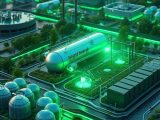
Valmet Automates 20 MW Hydrogen Fuel Cell Plant in Naepo New Town
October 30, 2025Setting the Stage
Since South Korea rolled out its Hydrogen Economy Roadmap in 2019, there’s been a real buzz about marrying existing energy assets with hydrogen fuel cells. Down in Naepo New Town, planners are tying a 500 MW LNG combined heat and power plant to a 20 MW hydrogen fuel cell facility. The idea? Build a sturdy, low-carbon microgrid that can meet growing electricity needs without sending emissions through the roof.
Order Highlights & Timeline
Fast forward to October 28, 2025, when Valmet Oyj announced it had clinched the deal to supply the brains and brawn—advanced automation and flow control—for the Naepo greenfield project. The centerpiece is a state-of-the-art Distributed Control System (DCS) set to manage 48 side-by-side hydrogen fuel cells. Here’s the rollout schedule:
- 2025 Q3: Order lands in Valmet’s books (they’re keeping the sticker price under wraps)
- January 2026: Automation system ships out
- Mid-2026: System goes live and ties into the existing LNG plant
- 2027 onwards: Hitting full commercial stride
Technical Deep Dive
Digging a bit deeper under the hood, Valmet’s DCS builds on decades of experience in complex process industries. It highlights how top-notch fuel cell technology comes to life. Here’s what it’s set to handle:
- Real-time monitoring of cell voltage, temperature and pressure
- Load distribution algorithms to squeeze out every drop of efficiency
- Smart alarm management and predictive maintenance nudges
- An analytics dashboard tracking performance trends and optimization
“Our system bridges the gap between traditional power plants and novel hydrogen technology,” says Wanmo Yoon, Sales Manager at Valmet. “We’re giving operators the insights they need to keep the power humming and emissions in check.”
Collaborative Framework
On the build side, Lotte Engineering & Construction is the EPC whiz, handling everything from concrete pours to hydrogen handling and hooking the new plant into the grid. “Valmet’s automation know-how is key to nailing Naepo City’s clean energy targets,” notes Changhyun Jung, Manager at Lotte E&C. And once the shovels are stashed, Naepo Green Energy Company takes the reins, blending revenue from both LNG and hydrogen-based power.
This isn’t their first rodeo together. Their teamwork on a biomass power plant showed they can mesh renewable energy with heavy industry seamlessly, and paved the way for this hydrogen chapter.
Historical Context & Previous Collaborations
Back in 2021, Valmet and Lotte E&C teamed up on a 50 MW biomass-fired power plant near Incheon. Valmet’s automation chops shaved 30% off startup times and boosted uptime, proving the concept. That success set the stage for Naepo’s hydrogen venture. At the same time, South Korea’s push to weave biomass, wind and solar under one digital roof created a blueprint for end-to-end digitalization—now being applied to hydrogen infrastructure.
Government Support Mechanisms
The Korean Ministry of Trade, Industry & Energy (MOTIE) is putting its money where its mouth is, carving out over KRW 1.5 trillion (around €1.1 billion) through 2026 for hydrogen R&D and commercialization. Here’s what they’re offering:
- Capital grants covering up to 40% of demonstration project costs
- Tax breaks for importing fuel cell modules and electrolyzers
- Feed-in tariffs that pay a premium for zero-emission power on the grid
Supply Chain & Tech Sourcing
Those fuel cell stacks come from a leading European manufacturer under a separate equipment deal, designed for modular scaling. Valmet’s DCS will chat with them over high-speed Profibus and OPC UA networks, ensuring secure, real-time data handoffs. It ties straight into SCADA, historian databases and cloud-based analytics platforms for predictive maintenance and long-term performance benchmarking.
Policy & Market Context
Seoul’s national strategy aims to add 15 GW of hydrogen capacity by 2040, backed by subsidies and R&D funding. The government views hydrogen as a linchpin for decarbonizing shipping, heavy industry and power generation. At the same time, international investors have their sights set on Asia’s rapid uptake, making Naepo a litmus test for large-scale industrial decarbonization.
Environmental & Economic Impacts
Swapping out part of that 500 MW LNG output for 20 MW of zero-emission generation could cut thousands of tonnes of CO2 each year. That breaks down into:
- A leaner greenhouse gas footprint
- A more diversified fuel mix and stronger energy security
- Local job creation during construction and operation
- An acceleration of nearby clean energy supply chains
Of course, scaling up hinges on a reliable flow of low-carbon hydrogen—ideally green hydrogen made via renewable-powered electrolysis.
Challenges & Risk Factors
It’s not all smooth sailing. A few hurdles remain:
- High upfront costs for fuel cell stacks and hydrogen storage
- The juggling act of integrating the DCS, the LNG plant and the grid
- Competition from battery storage and other low-carbon technologies
- Regulatory uncertainty around hydrogen tariffs and safety standards
Nailing these challenges will be crucial if Naepo’s model is to be replicated in other industrial hubs.
Community & Regional Development
Naepo New Town is fast transforming into a tech-centric municipality. Beyond power generation, developers are mapping out:
- Hydrogen refueling stations for buses and light vehicles
- R&D centers zeroing in on hydrogen storage and distribution
- Local training programs for fuel cell maintenance
- Public-private partnerships to pilot zero-emission transit
All that activity should draw startups and research institutions, cementing Naepo’s reputation as a living lab for sustainable energy innovation.
Financial & Investment Angle
Valmet’s keeping the contract value under wraps, but analysts estimate the DCS package alone tops €10 million. Across the whole plant—civil works, fuel cell modules and everything in between—capex could near €70–80 million. Financing comes from equity by Naepo Green Energy Company, syndicated bank loans and potential green bonds issued by the city.
Annual returns will hinge on hydrogen tariffs, which are expected to slide 20–25% over the next five years as electrolyzer costs fall and renewable electricity prices stabilize.
Performance Metrics & KPIs
Here’s the scoreboard everyone will be watching:
- Stack lifespan and degradation rate (target: >8,000 hours/year)
- Overall plant efficiency (target: >55% LHV basis)
- System availability (target: >95%)
- Emission reduction vs. baseline LNG plant (target: >15% CO2 cut)
- Operational expenditures (target: <€50/MWh)
Looking Ahead
For Valmet and Lotte E&C, landing the Naepo gig is a real badge of honor in the growing hydrogen market. If everything runs smoothly, Naepo could become the blueprint for large-scale hydrogen projects across Asia. Investors and policymakers will be glued to those performance stats—any efficiency gains or hiccups could sway future funding rounds.
Beyond Naepo, the insights gained here may steer projects in Japan, Australia and Europe that are chasing similar decarbonization paths. The next big leap? Linking multiple hydrogen hubs into regional networks, all underpinned by smart controls and digital twins.
About Valmet Oyj
Born in Finland with roots stretching back over 225 years, Valmet Oyj provides technologies and services for the pulp, paper, energy and process industries. In 2024, it posted €5.4 billion in net sales and employed more than 19,000 people. Valmet’s portfolio spans advanced automation, flow control and bioproducts, with recent bets on green hydrogen, biomass and circular solutions.


 With over 15 years of reporting hydrogen news, we are your premier source for the latest updates and insights in hydrogen and renewable energy.
With over 15 years of reporting hydrogen news, we are your premier source for the latest updates and insights in hydrogen and renewable energy.